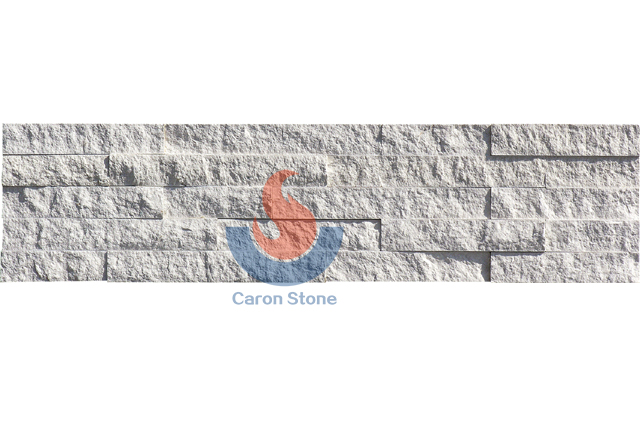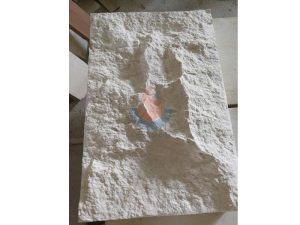
Limestone Carving Art: A Combination Of Traditional Craftsmanship And Modern Design -
As an ancient and classic building and carving material, limestone has played an important role in the long river of history. From the Greek temples to the Egyptian tombs, limestone carving art has revealed its special beauty in many civilizations and historical eras. Limestone carving art has evolved from traditional workmanship to modern design with the changes of the times. This article will explore the development of limestone carving art, analyze the combination of traditional craftsmanship and modern design, and the innovations and challenges brought about by this combination.

Split face white limestone 30×15
Traditional craftsmanship of limestone carving art
Historical background
Limestone carving art has a long history. Craftsmen in ancient Egypt started working with limestone to create sculptures and architectural accents as early as 3000 BC. Many well-known sculptures and architectural works emerged as limestone cutting art peaked in ancient Greece and Rome. Traditional limestone carving technology has become a treasure in the world’s art treasure house with its exquisite craftsmanship and rich cultural connotations.
Traditional carving techniques
The traditional limestone carving process usually includes the following steps: The craftsmen will first choose the suitable limestone block based on the design drawings, then progressively shape the fundamental form of the carving by means of hammers and chisels. Next, the craftsmen will use fine chisels and grinding tools to finely carve, gradually showing the delicate details. At last, the carving works are ideal by hand grinding and polishing. Every knife and every moment of the craftsmen displays their love and search of art since this ancient work calls for a great degree of knowledge and experience.
The cultural significance of traditional limestone carving
Traditional limestone carving is not only a form of artistic expression, but also carries rich cultural and historical significance. Reflecting the ancient Egyptians’ belief in gods and the afterlife, ancient Egyptian carvings are frequently used to embellish religious sites and tombs; ancient Greek carvings convey the devotion of stories and heroes, therefore reflecting the philosophical ideas and aesthetic notions of the ancient Greeks. Along with displaying the degree of workmanship at the period in the long river of history, these traditional carvings have left priceless cultural legacy for next generations.
Combination of modern design and limestone carving
Modern design ideas: Introduction
With the advancement of science and technology and the change of design concepts, modern limestone carving art has incorporated many new design elements and concepts on the basis of traditional craftsmanship. Modern designers have started to create many original and inventive works by using abstract art, geometric shapes and modern styles to limestone carving. Modern carving works, for instance, frequently mix dynamic lines and strong geometric patterns, therefore transcending the constraints of traditional carving and rendering limestone carving art more varied and avant-garde.
Technological progress
The development of modern science and technology has also had a profound impact on limestone carving art. CNC carving technology and computer-aided design (CAD) have helped to make limestone cutting more exact and quick. Digital tools allow designers to create intricate patterns and employ CNC engraving equipment to achieve exacting carving. These technical developments not only increase the variety of expression of carving art, so enabling designers to realize more innovative ideas, but also enhance the accuracy of carving, so enabling.
Integration of modern art and traditional craftsmanship
Modern limestone carving art presents a diverse style in the combination of traditional craftsmanship and modern design concepts. Many designers and artists have kept the core of conventional carving methods while adding current art components into the creative process to produce works with a feeling of the times and artistic integrity. Some contemporary carving works, for instance, blend ancient religious symbols with modern abstract components to create a new artistic style; other works show the vast opportunities of limestone carving art by creative workmanship and material application.
Challenges and Opportunities
Modern architecture and technology provide certain difficulties even if they have offered many possibilities and improvements for limestone cutting art. For instance, in some cases traditional carving techniques cannot be completely linked with modern technology, which may lead to the loss of skills; at the same time, modern designers must balance the relationship between tradition and innovation in the creative process and avoid too ambitious pursuit of modern style and neglect of the cultural connotation of limestone carving. Therefore, in the development of modern limestone carving art, how to maintain the essence of traditional craftsmanship and integrate modern design concepts is a question worth pondering.

Split face white limestone
In the long river of history, limestone carving art has undergone a continuous evolution from traditional craftsmanship to modern design. With its great talents and deep cultural implications, traditional workmanship has created a strong basis for limestone carving art; current design and technology have given limestone carving fresh vigor and inventiveness, therefore allowing it to continue to innovate and grow. The two together show the variety and limitless possibilities of limestone carving art as well as the ideal mix of modernism and legacy in artistic production. In the future, limestone carving art will continue to show a more exciting and rich artistic style at the intersection of tradition and innovation.




